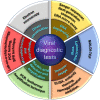Nanomaterials-based sensors for the detection of COVID-19: A review
- PMID: 35599642
- PMCID: PMC9110902
- DOI: 10.1002/btm2.10305
Nanomaterials-based sensors for the detection of COVID-19: A review
Abstract
With the threat of increasing SARS-CoV-2 cases looming in front of us and no effective and safest vaccine available to curb this pandemic disease due to its sprouting variants, many countries have undergone a lockdown 2.0 or planning a lockdown 3.0. This has upstretched an unprecedented demand to develop rapid, sensitive, and highly selective diagnostic devices that can quickly detect coronavirus (COVID-19). Traditional techniques like polymerase chain reaction have proven to be time-inefficient, expensive, labor intensive, and impracticable in remote settings. This shifts the attention to alternative biosensing devices that can be successfully used to sense the COVID-19 infection and curb the spread of coronavirus cases. Among these, nanomaterial-based biosensors hold immense potential for rapid coronavirus detection because of their noninvasive and susceptible, as well as selective properties that have the potential to give real-time results at an economical cost. These diagnostic devices can be used for mass COVID-19 detection to understand the rapid progression of the infection and give better-suited therapies. This review provides an overview of existing and potential nanomaterial-based biosensors that can be used for rapid SARS-CoV-2 diagnostics. Novel biosensors employing different detection mechanisms are also highlighted in different sections of this review. Practical tools and techniques required to develop such biosensors to make them reliable and portable have also been discussed in the article. Finally, the review is concluded by presenting the current challenges and future perspectives of nanomaterial-based biosensors in SARS-CoV-2 diagnostics.
Keywords: COVID‐19; SARS‐CoV‐2; biosensors; coronavirus sensor; nanomaterial‐based biosensors; pandemic; point of care diagnosis.
© 2022 The Authors. Bioengineering & Translational Medicine published by Wiley Periodicals LLC on behalf of American Institute of Chemical Engineers.
Conflict of interest statement
There are no conflicts of interest to declare.
Figures











Similar articles
-
Biosensors: frontiers in rapid detection of COVID-19.3 Biotech. 2020 Sep;10(9):385. doi: 10.1007/s13205-020-02369-0. Epub 2020 Aug 11. 3 Biotech. 2020. PMID: 32818132 Free PMC article. Review.
-
Clinical utility of novel biosensing platform: Diagnosis of coronavirus SARS-CoV-2 at point of care.Mater Lett. 2021 Dec 1;304:130612. doi: 10.1016/j.matlet.2021.130612. Epub 2021 Aug 6. Mater Lett. 2021. PMID: 34381287 Free PMC article.
-
Prospects of nanomaterials-enabled biosensors for COVID-19 detection.Sci Total Environ. 2021 Feb 1;754:142363. doi: 10.1016/j.scitotenv.2020.142363. Epub 2020 Sep 16. Sci Total Environ. 2021. PMID: 33254928 Free PMC article. Review.
-
Nanomaterials to tackle the COVID-19 pandemic.Emergent Mater. 2021;4(1):211-229. doi: 10.1007/s42247-021-00184-8. Epub 2021 Feb 12. Emergent Mater. 2021. PMID: 33615139 Free PMC article. Review.
-
Recent Progress in Graphene- and Related Carbon-Nanomaterial-based Electrochemical Biosensors for Early Disease Detection.ACS Biomater Sci Eng. 2022 Mar 14;8(3):964-1000. doi: 10.1021/acsbiomaterials.1c00710. Epub 2022 Mar 1. ACS Biomater Sci Eng. 2022. PMID: 35229605 Review.
Cited by
-
Advances in Biosensing Technologies for Diagnosis of COVID-19.Biosensors (Basel). 2022 Oct 20;12(10):898. doi: 10.3390/bios12100898. Biosensors (Basel). 2022. PMID: 36291035 Free PMC article. Review.
-
Batteryless wireless magnetostrictive Fe30Co70/Ni clad plate for human coronavirus 229E detection.Sens Actuators A Phys. 2023 Jan 1;349:114052. doi: 10.1016/j.sna.2022.114052. Epub 2022 Nov 24. Sens Actuators A Phys. 2023. PMID: 36447950 Free PMC article.
-
Biosensors based detection of novel biomarkers associated with COVID-19: Current progress and future promise.Biosens Bioelectron X. 2022 Dec;12:100281. doi: 10.1016/j.biosx.2022.100281. Epub 2022 Nov 14. Biosens Bioelectron X. 2022. PMID: 36405494 Free PMC article. Review.
-
Nanomaterial-Based Biosensors for the Detection of COVID-19.Indian J Microbiol. 2025 Mar;65(1):120-136. doi: 10.1007/s12088-024-01336-0. Epub 2024 Jun 23. Indian J Microbiol. 2025. PMID: 40371045
-
Diagnostic Tools for Rapid Screening and Detection of SARS-CoV-2 Infection.Vaccines (Basel). 2022 Jul 28;10(8):1200. doi: 10.3390/vaccines10081200. Vaccines (Basel). 2022. PMID: 36016088 Free PMC article. Review.
References
Publication types
LinkOut - more resources
Full Text Sources
Miscellaneous

